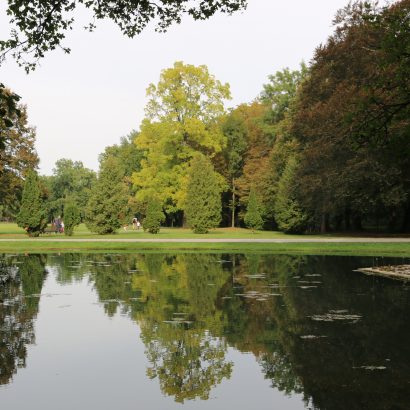Castle Park
The Castle Park is the biggest landscape garden in Austria. Laxenburg has an important history with roots in the 13th century.
Laxenburg is situated about 15 km south of Vienna. The historical importance of the village “Lachsendorf” has its roots in the 13th century and it was already in 1388 under the reign of duke Albrecht III that Laxenburg became a “Marktgemeinde” (a special kind of village in Austria). Even in these days, thanks to the vicinity of Schönbrunn castle, Laxenburg was the preferred residence during spring and summer of the imperial family.
It was not only the castle that grew but also the village of Laxenburg. The emperor and his court were among the guests and brought aristocracy and high society to Laxenburg. Courtly life reached its peak in the 18th century, at the time of Maria Theresia: performances of the Vienna “Hofburgtheater”, entertainment and show tournaments determined social life.
Laxenburg has developed in its favour for the last years. Its high quality of life, a high value of leisure and relaxation, many cultural offers, best infrastructure and high environmental standards offer Laxenburgs population and guests a comfort that is responsible for an attractive life in Laxenburg.
During the last decades Laxenburg has developed to a modern and productive location for industry and commerce. It has become an attractive place for traders and large enterprises in the south of Lower Austria. Many international organisations and institutions are situated in Laxenburg and that is why Laxenburg is known outside Austria as well.
The castle grounds are without any doubt the heart of Laxenburg. Laxenburg castle is one of the most impressing in castles in Europe. Its castle grounds are considered to be a showpiece as far as it concerns the horticulture of the 18th/19th century. It was Maria Theresia together with her grand-son, emperor Franz who were responsible for the expansion of the park to 280 hectares. The gardens are decorated in a lovely and fanciful way. In addition to the “blue court” (“Blauer Hof”) there is a high number of buildings of joy, mystical grottos, temples and the medieval tournament site.
The best-known building is certainly the “Franzensburg” (a castle) which was built in the period from 1799 to 1801 and which was completed in 1835. It was emperor Franz II who was responsible for the construction of this reproduction of a medieval knights castle on an artificial island in the middle of the castles pond.
The equipment of these premises is considered to be the Austrian treasure-house. Today one finds a museum there which can be visited.
After her splendid wedding with emperor Franz Joseph, empress Sisi spent her honeymoon in Laxenburg. She loved endless riding-outs through Laxenburgs woods. It was also in Laxenburg castle where her son crown prince Rudolph was born.
Laxenburg castle grounds as a whole are not only under a preservation order, but they also are part of the European project called “Natura 2000”. A lot of attractive leisure facilities offer everything ones heart desires to over one million visitors per year. There is a panorama train passing many sights, children can enjoy themselves on a tremendous play-ground with an area that is close to nature or they can take a ride on a pony or go by horse and cart. No matter if you want to be sporty (you can rent a boat for the pond of the castle which has 25 hectares), or if you are interested in culture (there are guided tours in Franzensburg museum or a visit called “Hoher Turm und über die Dächer”) or if you want to enjoy a good meal, Laxenburg offers diversity and flair.
You get more information about the prices of the castle grounds, reduction or guided tours on our homepage www.schloss-laxenburg.at or by phone 0043/2236/71226. Note: The season in the castle grounds lasts from Easter to All Saints Day. The gardens themselves can be visited all year round (entrance fee).
The tradition of the village with all its historical importance does not only manifest itself in the castle grounds but in many other places of the village. There is a cultural walk (Laxenburger Kultur-Parcours) which leads the visitor to over 50 stops, which are not only within the castle grounds, but which offer an insight into the most important sights of the village.
The parish church represents an important showpiece of the early Austrian baroque. Todays form has its origins in the time after the war against Turkey in 1683. Kaunitz-Wittgenstein palace reminds the visitor of the town palace of Kaunitz-Questenberg in Vienna, because of its Joseph-classical design; today it is part of monastery called “Kreuzschwestern”. The “Grünne-Haus” is the most elegant palace of aristocracy. It was bought and enlarged by Maria Theresia for her daughter Marie Christine and her husband Albert von Sachsen-Teschen. There is also the “emperors train station” (Kaiserbahnhof) which was built from 1850 onwards and completely renovated in the years 1999/2000. It is a revitalised dead-end train station of the line Mödling-Laxenburg and is the only train station in Europe in “Biedermaier” style that has been preserved. Today it is a preferred centre of communication and events.
Laxenburg is the home of Europes most modern film archives. There you can find more than 120.000 roles and that is why it is the biggest film collection in Austria. Exhibitions and retrospectives of the Austrian film archives have their origins in Laxenburg.
In Laxenburg you can also find a conference centre . The elegant and modern conference centre is situated in the premises of the castle and of its theatre and has room for conferences, banquets, balls and concerts.


